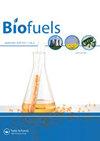从牛粪草堆肥中分离的嗜热细菌利用花卉废弃物生产生物乙醇的潜力
IF 2.6
4区 工程技术
Q3 ENERGY & FUELS
引用次数: 0
摘要
近年来,利用嗜热细菌从木质纤维素生物质(LCB)中生产生物乙醇的研究取得了很大进展。采用富集技术从牛粪草堆肥中分离出12株嗜热产乙醇菌,并对产乙醇量最高的菌株CSD6进行了进一步研究。CSD6利用戊糖和己糖生产乙醇、乳酸和乙酸为主要可溶性产物,通过16S rRNA基因测序鉴定为嗜脂热地杆菌菌株。在55°C和初始pH 7.5条件下,5 g/L葡萄糖的乙醇产量最高为25.05 mM,相当于理论乙醇产量的55%。该分离物对乙醇、乙酸浓度和初始底物负荷的耐受性均为中等。利用高压灭菌处理的混合花卉废弃物(FW)作为无成本底物,研究了CSD6的生物乙醇潜力。使用20 g/L FW作为底物,无需任何酶处理,CSD6最多可生产8.9 mM的生物乙醇,还原糖减少75.47%,表明CSD6能够从容易获得的底物中生产生物乙醇。感谢印度那格浦尔CSIR- NEERI主任为我们提供了必要的设施和资金。我们还要感谢neeri的csir Anshuman A. Khardenavis博士允许我们使用他的实验室设施。作者贡献:概念、方法、调查、验证、写作-原稿、审稿和编辑;PJY:调查,写作-审查和编辑;MSK:监督,构思,写作-审查和编辑披露声明作者未报告潜在的利益冲突。数据可用性声明本研究过程中产生的所有数据都包含在本文中。注1 LCB—木质纤维素生物质,FW—花卉废弃物,GHG—温室气体,MSW—城市固体废弃物,CBP—综合生物处理,PCR—聚合酶链反应,CMC—羧甲基纤维素,TS—总固体。本研究没有从公共、商业或非营利部门的资助机构获得任何特定的资助。本文章由计算机程序翻译,如有差异,请以英文原文为准。
Potential of thermophilic bacteria isolated from cow dung-grass compost for bioethanol production using floral waste
AbstractIn recent years, various efforts have been invested in producing bioethanol from lignocellulosic biomass (LCB) using thermophilic bacteria. Twelve thermophilic ethanologenic bacteria were isolated from cow dung-grass compost using an enrichment technique, and the isolate, CSD6, which produced the highest bioethanol, was studied further. CSD6 utilized both pentose and hexose sugars producing ethanol, lactic acid and acetic acid as major soluble products and was identified through 16S rRNA gene sequencing as a strain of Geobacillus stearothermophilus. The highest ethanol production was found to be 25.05 mM from 5 g/L glucose, equivalent to 55% of the theoretical ethanol yield at 55 °C and initial pH 7.5. The isolate showed average tolerance to ethanol and acetic acid concentration and initial substrate loading. The bioethanol potential of CSD6 was also studied using autoclave-treated mixed floral waste (FW) as a no-cost substrate. CSD6 produced a maximum of 8.9 mM of bioethanol with a 75.47% decrease in reducing sugars using 20 g/L FW as substrate without any enzymatic pretreatment, indicating the ability of CSD6 to produce bioethanol from easily available substrates.Keywords: Bioethanol productionfloral wastethermophilic bacteriaGeobacillus AcknowledgementWe are thankful to the Director, CSIR- NEERI, Nagpur, India, for providing the necessary facilities and funds. We also would like to thank Dr. Anshuman A. Khardenavis, CSIR-NEERI, for allowing us to use his laboratory facilities.Author’s contributionSD: Conceptualization, Methodology, Investigation, Validation, Writing-Original Draft, Review and editing; PJY: Investigation, Writing- Review and Editing; MSK: Supervision, Conceptualization, Writing- Review and EditingDisclosure statementNo potential conflict of interest was reported by the author(s).Data availability statementAll data generated during this study are included in this manuscript.Notes1 LCB- Lignocellulosic biomass, FW- Floral waste, GHG- Green house gas, MSW- Municipal solid waste, CBP- Consolidated bioprocessing, PCR- Polymerase Chain Reaction, CMC- carboxymethyl cellulose, TS- Total solid.Additional informationFundingThis research did not receive any specific grant from funding agencies in the public, commercial, or not-for-profit sectors.
求助全文
通过发布文献求助,成功后即可免费获取论文全文。
去求助
来源期刊

Biofuels-Uk
Energy-Renewable Energy, Sustainability and the Environment
CiteScore
5.40
自引率
9.50%
发文量
56
期刊介绍:
Current energy systems need a vast transformation to meet the key demands of the 21st century: reduced environmental impact, economic viability and efficiency. An essential part of this energy revolution is bioenergy.
The movement towards widespread implementation of first generation biofuels is still in its infancy, requiring continued evaluation and improvement to be fully realised. Problems with current bioenergy strategies, for example competition over land use for food crops, do not yet have satisfactory solutions. The second generation of biofuels, based around cellulosic ethanol, are now in development and are opening up new possibilities for future energy generation. Recent advances in genetics have pioneered research into designer fuels and sources such as algae have been revealed as untapped bioenergy resources.
As global energy requirements change and grow, it is crucial that all aspects of the bioenergy production process are streamlined and improved, from the design of more efficient biorefineries to research into biohydrogen as an energy carrier. Current energy infrastructures need to be adapted and changed to fulfil the promises of biomass for power generation.
Biofuels provides a forum for all stakeholders in the bioenergy sector, featuring review articles, original research, commentaries, news, research and development spotlights, interviews with key opinion leaders and much more, with a view to establishing an international community of bioenergy communication.
As biofuel research continues at an unprecedented rate, the development of new feedstocks and improvements in bioenergy production processes provide the key to the transformation of biomass into a global energy resource. With the twin threats of climate change and depleted fossil fuel reserves looming, it is vitally important that research communities are mobilized to fully realize the potential of bioenergy.
 求助内容:
求助内容: 应助结果提醒方式:
应助结果提醒方式:


